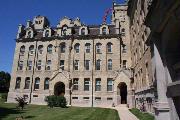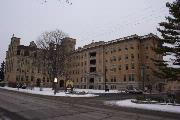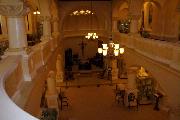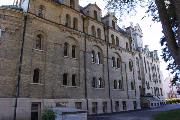Property Record
13105 WATERTOWN PLANK RD
Architecture and History Inventory
| Historic Name: | VISITATION CONVENT COMPLEX - NOTRE DAME HALL |
|---|---|
| Other Name: | NOTRE DAME HEALTH CARE CENTER/School Sisters of Notre Dame |
| Contributing: | Yes |
| Reference Number: | 7900 |
| Location (Address): | 13105 WATERTOWN PLANK RD |
|---|---|
| County: | Waukesha |
| City: | Elm Grove |
| Township/Village: | |
| Unincorporated Community: | |
| Town: | |
| Range: | |
| Direction: | |
| Section: | |
| Quarter Section: | |
| Quarter/Quarter Section: |
| Year Built: | 1899 |
|---|---|
| Additions: | |
| Survey Date: | 19791975 |
| Historic Use: | religious residence |
| Architectural Style: | German Renaissance Revival |
| Structural System: | |
| Wall Material: | Cream Brick |
| Architect: | Eugene Liebert |
| Other Buildings On Site: | |
| Demolished?: | No |
| Demolished Date: |
| National/State Register Listing Name: | Visitation Convent Complex |
|---|---|
| National Register Listing Date: | 5/25/2011 |
| State Register Listing Date: | 2/18/2011 |
| National Register Multiple Property Name: |
| Additional Information: | A 'site file' exists for this property. It contains additional information such as correspondence, newspaper clippings, or historical information. It is a public record and may be viewed in person at the Wisconsin Historical Society, Division of Historic Preservation. Other buildings associated with this record include: Maria Hall (AHI #17061), Tuberculosis Hospital (AHI # 170602), Boiler House (AHI #170661), West Wing Holy Family Infirmary (AHI #170663), East Wing Holy Family Infirmary (AHI #170664), St. Mary’s Orphanage (AHI #170681), Our Lady of Lourdes Grotto (AHI #170682), Fidelis Hall (AHI #170701), Holy Family Chapel (AHI #170702), Cemetery Gate (AHI #170721), Cemetery (AHI #170722), Garage #1 (AHI #170741), Garage #2 (AHI #170742). The B in the photo code stands for BKFD. Another map name is R. A. Smith, revised 1993. DESCRIPTION: The buildings of the convent and orphan asylum built by the Sisters of Notre Dame dominate the streetscape of Elm Grove. The three and one half story brick structure standing closest to Water Plank Road, (identified as the 1899 House of Rest), with round-arched arcaded window openings includes a stepped gable on the north end in the German fashion. The original main entrance was through an engaged tower form centered on the east facade; the tower has deeply chamfered edges through the second and third stories, terminating in a castellated parapet. The massive rooftop form above this tower may have been added sometime later: It rises an additional story above the roof, occupying a rectangular space from facade to roof ridge and is topped by multi-gable roofs and turrets. Small dormers rise from both sides of the main roof, each containing a round-arched window opening. At the south end of this portion is a similarly-sized addition (known as "The Castle") containing the chapel. Constructed in 1899, it uses many of the same stylistic features found in the northern portion. Its two story round ended apse is decorated with corbeling patterns and brick pilasters. A parapeted gable rises above the apse and ends the three and one half story portion. Corbelled square towers (which originally contained water openings is situated to the west of the apse and below the castle-like square towers. A five-story Neo-Classical wing extends westward from the "castle." Above an articulated dressed limestone base, the brick walls rise four floors and are devoid of ornament save the limestone window lintels with keystones. A broad cornice with dentils and consoles is topped with a roof-top balustrade. This wing was built in 1921, when the original convent and church were demolished. The orphanage, the institution of which dates to 1859, is a stepped-gable three and one half story brick structure incorporated into a wing extending to the south from the western end of the 1921 addition. Its stepped gables protrude from both the east and west sides of the building; the dormered, gambrel roofed wing dates from 1903. The buildings are used today as part of a retirement home and health care center operated by the Sisters of Notre Dame. ARCHITECTURAL/ENGINEERING SIGNIFICANCE: Of the many buildings of the convent/orphanage complex, the most distinctive architectural features are the elements that express the German heritage of the founding Sisters, such as the stepped gables, and the castle-like appearance that make this complex a visual landmark in Elm Grove. HISTORICAL BACKGROUND: Mother Caroline Friess was born in 1824 near Paris, France. Her father was said to be a very wealthy Bavarian, and at the age of 16 she entered a teaching Convent. She came to America in 1847 and taught in the East for a time, returning to Munich to ask permission to modify the rules of enclosure of the Sisters, believing that teaching Sisters in America needed greater freedom to function effectively. Eventually, she won her point, and in 1855, was instructed to return to the United States to establish schools and convents throughout the country. Coming to Wisconsin, it is told that her horse stopped at the bend in Watertown Plank Road and would go no further. Mother Caroline took this as a sign from God and on January 1, 1859 she purchased 20 acres on which to establish a convent. The money for her purchase resulted from her appeal to King Ludwig of Bavaira. He gave generous support to her efforts and specified that a Bavarian style of architecture be used for the buildings; more sisters were sent from Germany. The acreage was sold to her by George Betholz (listed as Betsall on the 1859 and 1873 Plat Maps, and Batzalt on the 1891 Plat Map); four of the Betholz daughters would eventually enter the convent and the remaining 280 acres of the farm would be bequeathed to the Sisters. A convent and orphanage were erected; a school was started in the convent; Our Lady of Visitation Orphanage opened on June 21, 1859 and a "House of Rest" was also constructed in 1859. St. Mary's Church was built in 1868 on the south side of Watertown Plank Road immediately west of the convent (church and convent demolished in 1921 for construction of a five story Marianum wing). In 1869 the Sisters had a subdivision platted comprising the 20 lots in the triangle formed by Watertown Plank Road, Juneau Boulevard (then called Leland Avenue) and Elm Grove Street. The plat was recorded in 1871. In 1886 a brick rectory or parsonage was constructed across Watertown Plank Road from the church; Reverend Joseph Huber was in charge of its construction, which cost $2,500. The chapel building, with towers and round apse, was construced in 1898 (cornerstone); the large chapel is said to be a replica of one of King Ludwig's ballrooms. A substantial addition to the stepped-gable orphanage was made in 1903; a five story wing replaced the church and convent in 1921. The new church had been built across the street, next to the parsonage, in 1920. The orphanage's name was changed to "Guardian Angel Orphanage" in 1923, and operated until its closing in 1940. Throughout the convent/orphanage's history, the large 280-acre farm was operated by the Sisters for income and sustenance. A block-long underground tunnel connected the convent to the large barns which stood to the east (barns demolished in 1970). In 1978, an archaeological site was located on the former farmlands and investigated. The Convent Knoll Site, (47wk327), proves that members of the Red Ocre or Copper Culture lived in this part of Waukesha County 3,000 years ago. HISTORICAL SIGNIFICANCE: The Convent's impact on the development of Elm Grove cannot be overlooked. The majority of early Elm Grove residents were German as were the founding Sisters, and the architecture of the Convent complex is a visual remainder of that heritage. By the time the railroad depot was built in 1864, an extensive, self supporting settlement with large-scale buildings of exotic design was already in existence. The connections with the Catholic church extend to the north side of Watertown Plank Road, where the 1886 parsonage and 1920 St. Mary's Church stand. Further research should be done to determine more exactly the stages of development of the various convent/orphanage buildings and names of any architects associated with them or St. Mary's Church. |
|---|---|
| Bibliographic References: | Elm Grove Elm Leaves 1/23/1997. Convent records. |
| Wisconsin Architecture and History Inventory, State Historic Preservation Office, Wisconsin Historical Society, Madison, Wisconsin |





